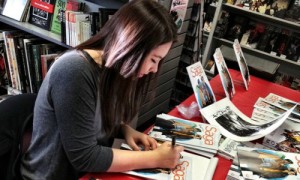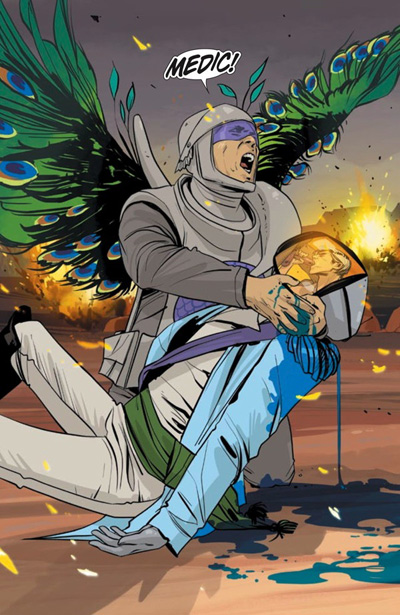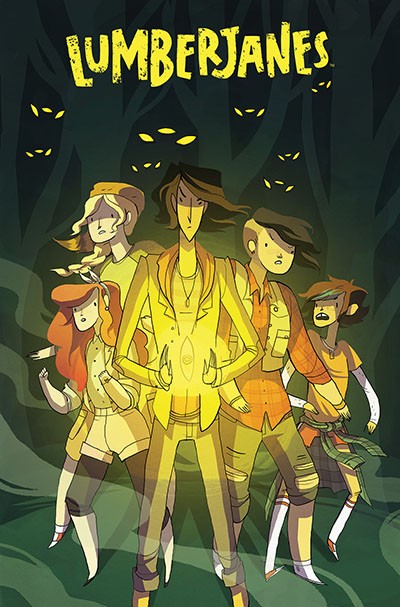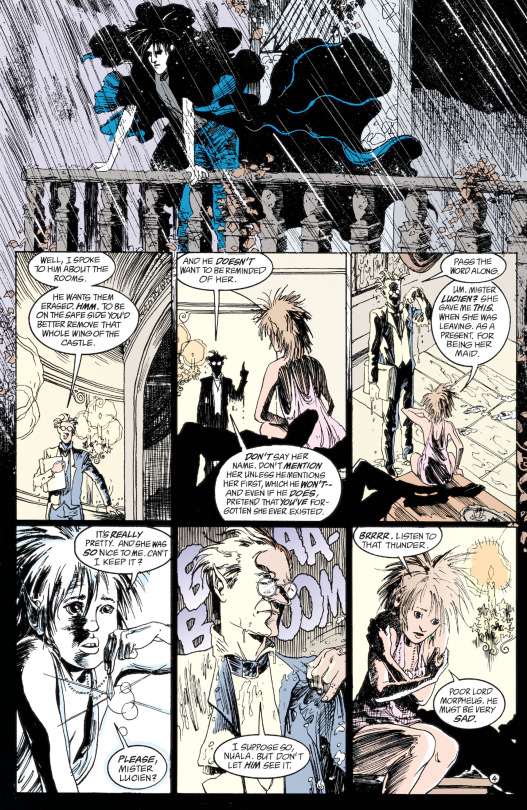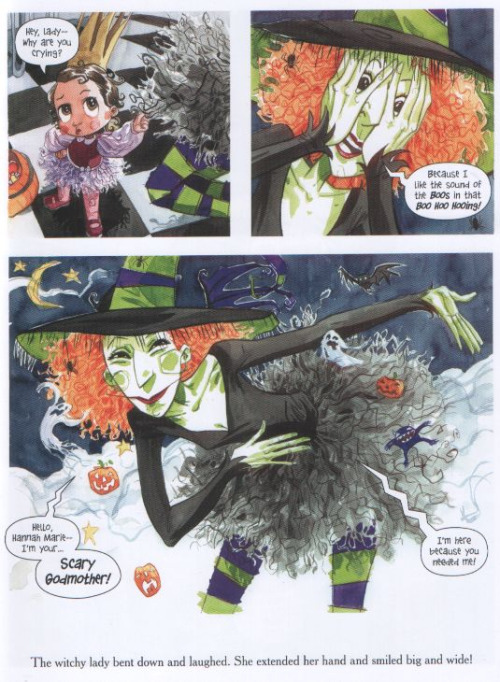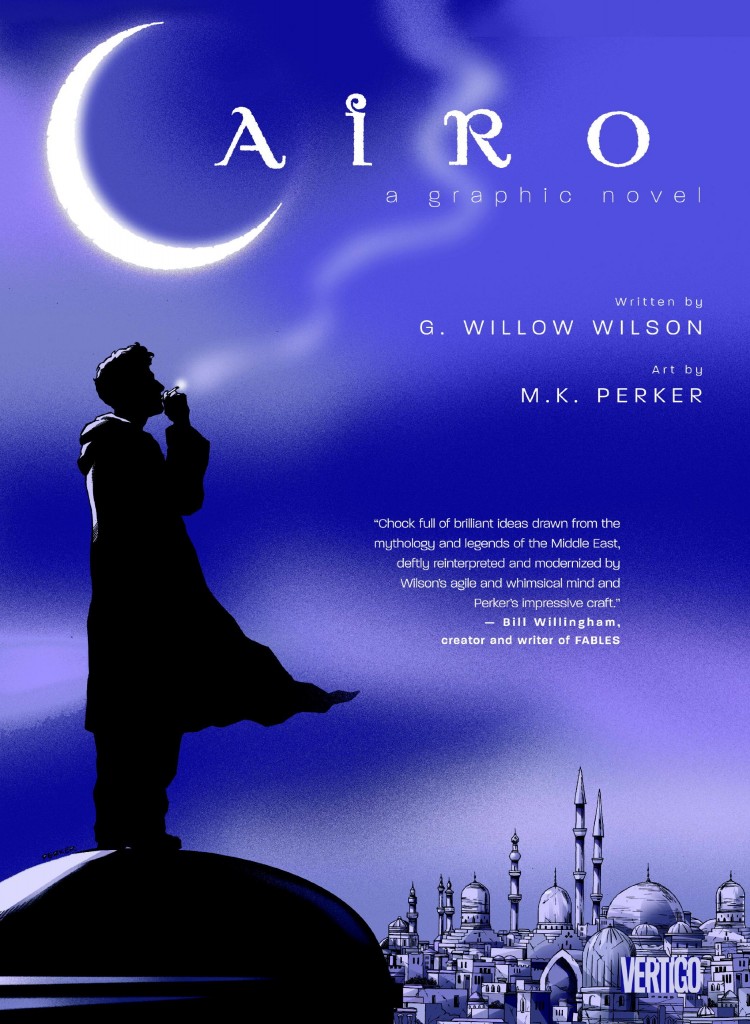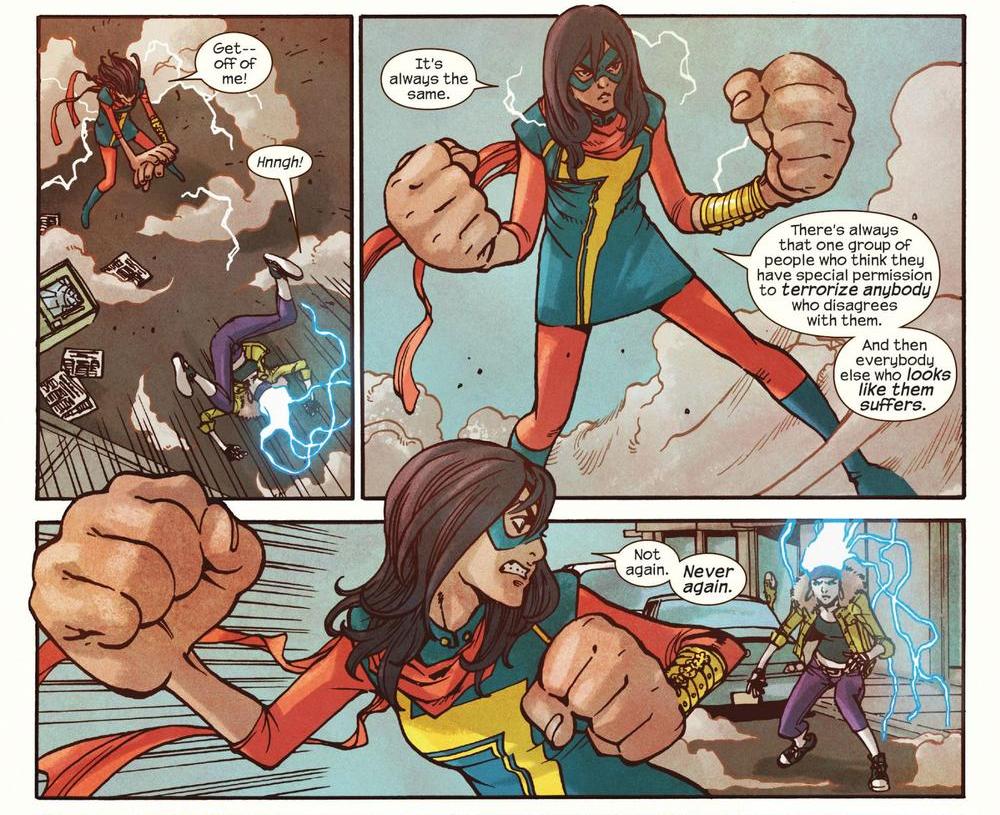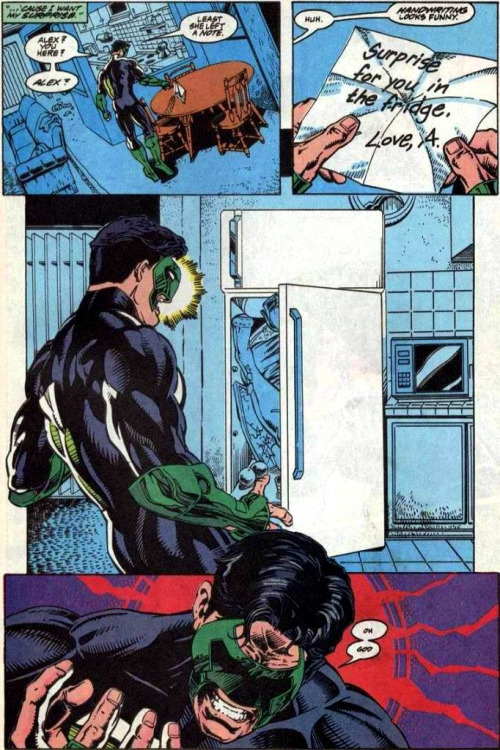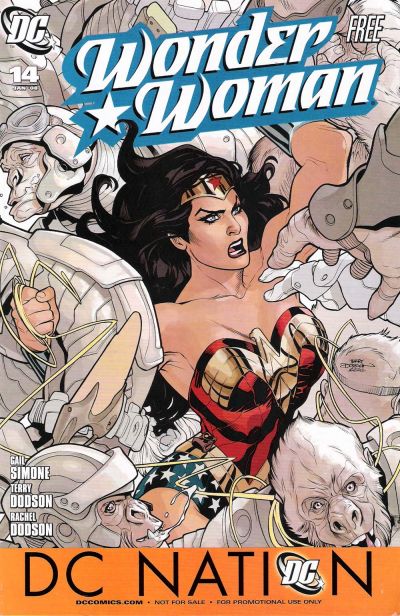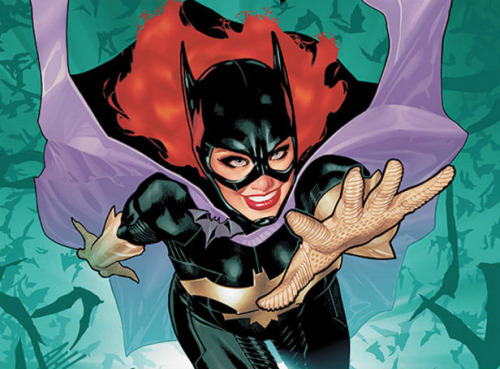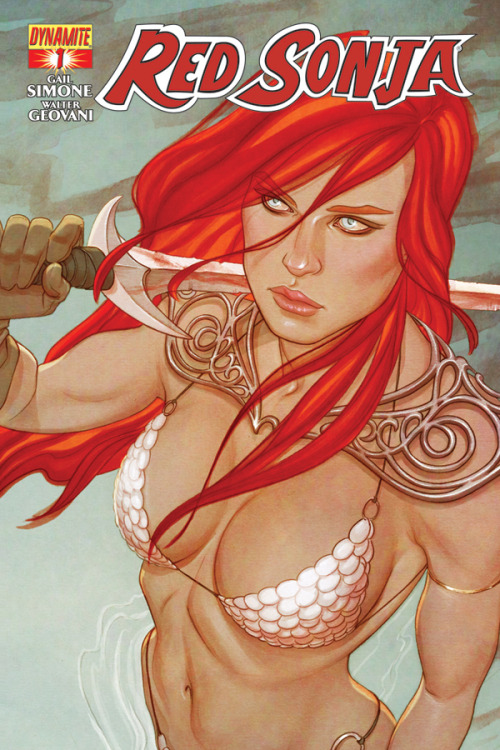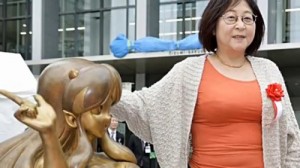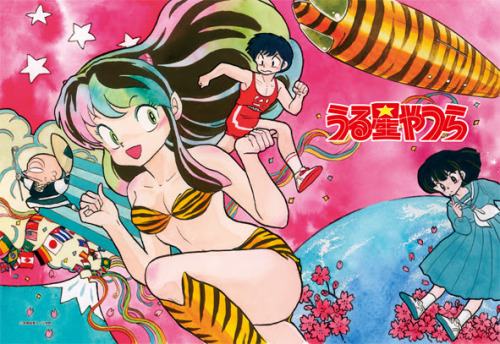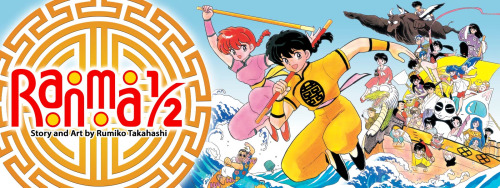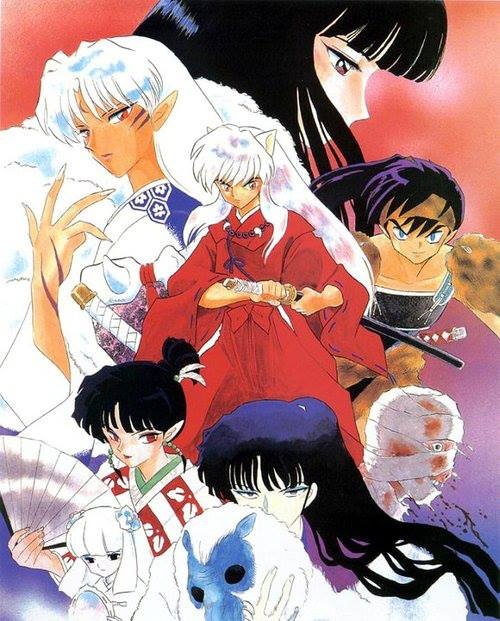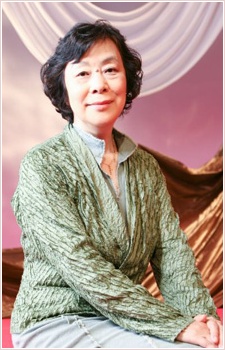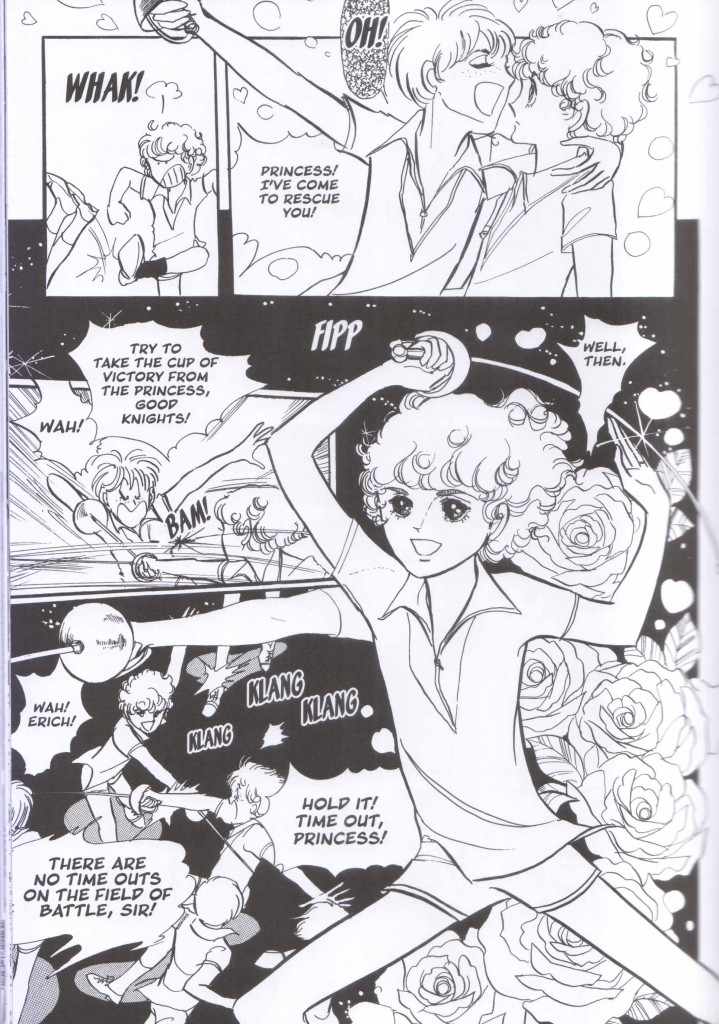Happy Women’s History Month! All through March, we’ll be celebrating women who changed free expression in comics. Check back here every week for biographical snippets on female creators who have pushed the boundaries of the format and/or seen their work challenged or banned.
Fiona Staples
The multiple award-winning Canadian comic artist, Fiona Staples has become one of the most recognizable and influential artists in the industry today. Voted top female comic book artist by Comic Book Resources in 2015, the co-creator of Saga has helped reshape modern comic art and storytelling. Her distinct style, design sense, and sometimes controversial content is not only pushing the boundaries of the modern industry to become a space more welcoming to other female creators, but also helping to open the doors to new era of independent, diverse, and creator-driven works.
Staples’ first foray into published comics was part of About Comics’ 24 Hour Comics Day Highlights 2005. Quickly recognized for her unique style and approach to character building, from there the artist would work on North 40, Mystery Society, and assortment of titles with DC. Staples has also done cover art for numerous other titles and contributed to independent projects like Beyond: An Anthology of Queer Sci-fi/Fantasy Comics.
In 2012, though, with the release of Saga—Staples and Brian K. Vaughn’s epic sci-fi space opera—the artist rose quickly to dominate numerous top creator lists and win dozens of comics awards. “The series’ wide appeal rests in no small part on Staples’s gorgeously organic and painterly artwork,” writes The Guardian. “Which brings a believable humanity to her fantasy environments and is about as far from stereotypically muscular comic art as can be imagined.” Her emphasis on the human experience, characterization, and world-building made her the perfect candidate to illustrate the new Archie reboot which the creator is currently working on. The whirlwind career that Staples has experienced since 2005 is a true testament not only to her immense talent, but her determination to remain true to her unique voice.
Despite the immense success that Staples has experienced, her work hasn’t been left unscathed by critics. In 2013, Saga #12 was temporarily pulled from the Apple App Store due to a controversial image that led to a misinterpretation of Apple’s content policies. In 2015 the series was listed by the American Library Association as one of the ten most challenged books of the 2014. A man at an undisclosed Oregon public library petitioned for removal of the first volume over sexually explicit content and “anti-family” themes, but the library stood behind the book.
“It’s definitely changing,” said Staples in an interview with Heroic Girls with regard to the state of the current comics industry. “Although maybe not as quickly as we’d like.”
All the corners of the comics world except mainstream superhero books have pretty much agreed that diversity is a positive thing. I think the important thing to do now is create women-friendly books, and that will lead to more female creators in the next generation.
In an industry dominated by such a variety of artists and writers, Staples has cemented herself as an admirable icon that will inspire generations of future artists. As The Guardian notes, “Staples is one of only a few women artists whose work and name can sell a book on its own.”
—by Caitlin McCabe
Noelle Stevenson
 At 24 years old, Noelle Stevenson has already had a hand in transforming comics for a new generation. From the freewheeling world of fanart and webcomics to the hallowed pages of Marvel Comics, her instantly recognizable illustrations and complex, relatable characters and storylines have left their mark and expanded comics readership, especially among female fans.
At 24 years old, Noelle Stevenson has already had a hand in transforming comics for a new generation. From the freewheeling world of fanart and webcomics to the hallowed pages of Marvel Comics, her instantly recognizable illustrations and complex, relatable characters and storylines have left their mark and expanded comics readership, especially among female fans.
While attending the Maryland Institute College of Art early this decade, Stevenson was already well-known online for her quirky fanart of franchises including Lord of the Rings and Doctor Who. When she was assigned to create a character for a class in her Junior year, she came up with Nimona, the accident-prone shapeshifting villain’s sidekick who would eventually go on to star in Stevenson’s webcomic of the same name. She incorporated Nimona and her world into several more class projects, then realized “I know what the ending is, I want to tell the story,” she recalled in an interview at the A.V. Club.
Stevenson began posting the webcomic Nimona, which doubled as her senior thesis, in 2012. In light of its instant success, she had a book deal with HarperCollins by the end of that year; the collected Nimona was published as a graphic novel in 2015. Thanks to networking via Tumblr, she also landed an internship at BOOM! Studios while still in college, and a job after graduation. There, she was first assigned to work on initial character development for the groundbreaking new all-ages comic Lumberjanes, but series editor Shannon Watters soon promoted her to co-writer due to her clear picture of character interactions and storyline development.
Lumberjanes, featuring a five-girl ensemble called to fight the supernatural entities that plague their summer camp, was an instant hit with readers of all ages–but particularly girls and women. Stevenson was excited for the opportunity to break down a trope that plagued many of the books she read in her youth, she recalled in an interview at Comics Alliance:
I didn’t associate myself with the girl characters. I was like, ‘Oh, you know – you have the team and I’m the girl,’ [but] I was like, ‘That’s not me.’ Her personality is ‘being a girl,’ and that is not a personality. I’m nerdy so I like that one over there; I like the nerd. Usually a boy character. It took me a really long time to get past all of that internalized dissociation with being female that I was being given by media.
With Lumberjanes, on the other hand, Stevenson and her co-creators were free to let each character develop her own unique personality without the concern that any quirks would be perceived as a function of gender. Readers responded enthusiastically, including many who had never considered themselves fans of comics. Lumberjanes won 2015 Eisner Awards for Best New Series and Best Publication for Teens, as well as a Harvey for Best Original Graphic Publication for Younger Readers. Around the same time, Stevenson’s solo work on Nimona also made the shortlist for the National Book Award.
In 2015 Stevenson left Lumberjanes to try her hand at writing for Disney’s animated TV series Wander Over Yonder and for Marvel’s rebooted Runaways comic, which saw four issues last year. Meanwhile, she and Wander Over Yonder colleague Todd Casey have also teamed up on a forthcoming illustrated series for teens called 4 Wizards. Whatever Stevenson does next in her already prolific career, she will surely continue to exemplify her own advice to aspiring creators: “Question everything, don’t try to emulate someone else’s path, look at what you have, the tools you have, the place you’re in, know the rules, and break them.”
–by Maren Williams
Jill Thompson
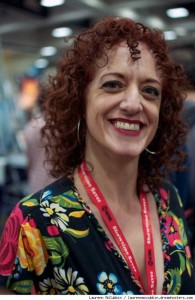 Whether it be comics, children’s books, or animation, multi-talented writer and illustrator Jill Thompson’s career is as diverse and colorful as the work she produces. Never one to shy from an opportunity for creativity and a space to express her creative visions freely, Thompson has been called the “most well-known, female comic book artist working in the comics industry today.”
Whether it be comics, children’s books, or animation, multi-talented writer and illustrator Jill Thompson’s career is as diverse and colorful as the work she produces. Never one to shy from an opportunity for creativity and a space to express her creative visions freely, Thompson has been called the “most well-known, female comic book artist working in the comics industry today.”
From DC, Marvel, and Dark Horse, to HarperCollins and Sirius Entertainment, the native Chicagoan and graduate of the American Academy of Art in Chicago has received numerous accolades for her work and become one of the premier voices in several industries. Recognized by the Eisner Awards and the National Cartoonists Society for her work on Neil Gaiman’s acclaimed series The Sandman, Dark Horse’s Beasts of Burden, and her own original series Scary Godmother, she has dominated the field of comics and children books and proved that having a little supernatural fun isn’t just for the guys. “She has risen to the top of the male-dominated field and has garnered acclaim for her work,” notes DC Comics.
Voted number four in Comic Book Resources Top 25 Female Artists of 2015, Brian Cronin writes, “What’s absolutely fascinating to me about Jill Thompson is that she is one of the few artists who have become a star artist using two fairly dramatically different art styles.” Thompson has drawn the clean lines of George Perez’s Wonder Woman; the wistful, fluid, and expressionistic-like dreams of the Sandman; and brightly colored and painterly fantasies of Beasts of Burden. An artistic chameleon, over the decades Thompson has adapted her style to best accompany the storytelling, and with this she has become a master of narrative illustration.
One of her greatest works though is her independently produced Scary Godmother. A kid’s picture book mixed with a comic, Scary Godmother recounts the adventures of the Halloween fairy godmother. After the near collapse of the comics industry in the 1990s, Thompson—a pioneer of kid’s comics genre— recallswanting to produce a book “that bridged the gap between children’s books and comic books because a lot of the comics I remember from my childhood were all ages friendly.” Scary Godmother was that title, and it would not only go on to bridge that gap and bring children into comics and vice-versa, but would also inspire a couple of animated feature films.
“Scary Godmother was one of those perfect storm situations,” notes Thompson. “It was right after the big comic implosion in the mid ‘90s… This is the story, the things I haven’t had for so long. People have been telling me to do my own thing, well this is my own thing.”
Thompson’s art isn’t just scary godmothers, depictions of the Endless, or even Wonder Woman, though. Never one to simply settle or sequester herself to a single creative space, the multi-faceted artist has also designed dolls, WWE costumes, and even dabbled in animation. As Cronin reminds us, “It is always cool when great artists re-invent themselves, but when great artists re-invent themselves and get even GREATER? Well, that’s a whole other (awesome) story.”
–by Caitlin McCabe
G. Willow Wilson
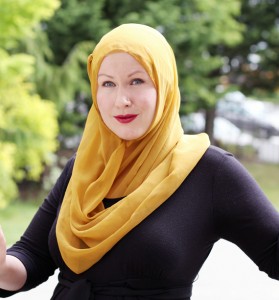 Since her 2007 graphic novel Cairo, G. Willow Wilson has sought to represent the Islam that she knows, which is very different from the version presented in much of American culture. With the critical and popular success of Ms. Marvel in 2014, Wilson has helped to redefine who can be a superhero and reshape societal perceptions of Muslim American women’s experiences.
Since her 2007 graphic novel Cairo, G. Willow Wilson has sought to represent the Islam that she knows, which is very different from the version presented in much of American culture. With the critical and popular success of Ms. Marvel in 2014, Wilson has helped to redefine who can be a superhero and reshape societal perceptions of Muslim American women’s experiences.
Gwendolyn Willow Wilson was born in 1982 in Long Branch, New Jersey. By the age of 17 she was a freelance music critic for the Boston-based magazine Weekly Dig. A hard-partying pink-haired teenager and the daughter of atheists, she surprised even herself by converting to Islam while attending Boston University. After graduation in 2003, she took a year-long job teaching history at an English-language high school in Cairo, Egypt.
Although she felt an instant connection to Cairo–“I’d never had such an intense, immediate relationship with a place before,” she said in an interview with Sara Elgobashy of the Middle East news site Elan–Wilson also experienced a certain amount of culture shock. In her 2010 memoir, for instance, she recalled how she and her roommate survived on scant provisions simply because they were mystified by the process of buying food in the chaotic marketplace. She adjusted better after striking up a friendship with Omar Haggag, the Egyptian physics teacher who would later become her husband.
Living in Cairo cemented Wilson’s conviction that she had made the right choice in converting to Islam. She contributed both journalism and introspective pieces about her personal and spiritual journey to periodicals including Atlantic Monthly and the New York Times Magazine. After moving back to the U.S. with her husband she wrote her first graphic novel Cairo, which incorporates mythological elements to tell the story of the city she loves. The book was published by DC in 2007 with art by M.K. Perker. It was chosen as a Top Ten Graphic Novel for Teens by the Young Adult Library Services Association, and School Library Journal named it one of the year’s Best Adult Books for High School Students.
In 2008 Wilson and Perker again collaborated to create the Vertigo series Air, about an acrophobic flight attendant caught up in paranormal events and post-9/11 fears of terrorism. Despite critical acclaim and a 2009 Eisner nomination for Best New Series, Air was cancelled in 2010 due to lack of sales. That same year, Wilson took a slight detour from comics with her non-graphic memoir The Butterfly Mosque: A Young American Woman’s Journey to Love and Islam. That book, she told Elgobashy, was in part a reaction to the anti-Muslim sentiment that she was surprised to see growing rather than decreasing over the years; she hoped instead to highlight “the quiet, wonderful, human sides of Muslim experience [that] are overlooked in the media.” In 2012 she tackled yet another genre with the urban fantasy novel Alif the Unseen, and was rewarded the next year with the World Fantasy Award.
In 2014 Wilson was hired to write the revolutionary new Ms. Marvel, in which the title formerly held by Carol Danvers was taken up by Kamala Khan, a Pakistani American Muslim teenager from New Jersey. Although Kamala is the first Muslim superhero to headline a Marvel series, Wilson’s writing and the art by Adrian Alphona show her to be eminently relatable, posting fanfiction online and sneaking out of the house to attend a party against her parents’ wishes. While learning to control her shapeshifting powers to battle supervillains, she also battles societal stereotypes of what Muslim women can do. The series met an enthusiastic response from fans hungering for more diverse characters and storylines, and received a 2015 Eisner nomination for Best New Series. Wilson was also nominated separately as Best Writer. Ms. Marvel Volume 1: No Normal won a 2015 Hugo Award for Best Graphic Story, and the entire run won the Series Prize at the 2016 Angoulême International Comics Festival.
Although Wilson and Ms. Marvel have also received a predictable measure of Islamophobic backlash from online trolls, she told Michael Paulson of the New York Times that “there’s no way to say anything intelligent about those things, because the entire conversation is based on nonsense.” What she can do to represent the richness and diversity of the Muslim American experience, she says, is “keep on telling different stories.”
–by Maren Williams
Gail Simone
In an era during which women have been persecuted and threatened for speaking out about sexism in geekdom, comics writer Gail Simone is an especially bright light for the cause of women in comics, using the medium to address, deconstruct, and overcome sexism. She also uses her formidable social media powers for good, fearlessly calling out misogyny in the comics industry and associated pop culture businesses.
Simone began her crusade for women’s free expression in comics by coining the phrase “women in refrigerators” as part of a collective of female comics fans who founded and contributed to a website of the same name in 1999. The phrase arose in response to a Green Lantern storyline in which Kyle Rayner’s girlfriend was murdered by a villain, dismembered, and stuffed into a refrigerator. “I asked the question, ‘Is this a trend in comic books where the female characters are only there to forward the male hero’s story?’” Simone told Katie Couric in a 2015 video for Yahoo News entitled “Rise of the Female Superhero.”
Simone and her compatriots compiled a list of female characters who had been “depowered, maimed, chopped up, raped” to advance the story of a male character. Not content to just create a list, Simone reached out the many of the creators who used the plot device. Her message was clear: “If you want to attract a female audience, you might want to take a look at this trend.”
While the response to Women in Refrigerators was mixed and the website was short lived, it was a drop of water that caused ripples throughout the industry and helped start a revolution in the ways female characters were depicted and treated. This is due in no small part to Simone herself, who was offered more opportunities to change free expression not just as an outsider who enumerated the crimes against female characters, but as a comic book writer. Simone began her foray into the medium first with The Simpsons for Bongo Comics, but she soon moved on to superhero comics, writing some of the most popular story arcs for fan-favorite Deadpool.
Simone moved on to DC Comics, helming immensely popular runs on some of DC’s flagship properties, including Wonder Woman, all-female superhero alliance Birds of Prey, and Batgirl. Simone wasn’t the first female writer to work on Wonder Woman, but she was the longest-running, writing 30 issues between 2008 and 2010. She clocked more than 60 issues of Birds of Prey before taking on Batgirl for DC’s New 52 initiative.
Having already written for Barbara Gordon in Birds of Prey, when the character was paraplegic technology and information expert Oracle, Simone was able to take the character from her wheelchair and into action as Batgirl. In reviewing the first issue of the series, The New York Times’ George Gustines praised Simone’s work, writing “Unlike some of the other DC comics I read this week, Batgirl achieves a deft hat trick: a well-shaped reintroduction to a character, an elegant acknowledgement of fundamental history and the establishment of a new status quo. This is a must-buy series.” In Simone’s hands, Batgirl was the most popular female-led New 52 series – in fact, it was one of the most popular series in the New 52 period – and it saw doubled sales over previous incarnations of the character.
In a strange chain of events, Simone was temporarily removed from Batgirl in 2012. The events surrounding Simone’s release were unclear, with some speculating that it was due to Simone’s outspokenness about the lack of women and diversity in the industry, but immediate fan outcry meant she was back on the title a scant few weeks later. She continued her run through 2014, during which time she introduced the first openly transgender character in mainstream comics, Barbara’s roommate Alysia Yeoh.
Most recently, Simone took on an icon of pulp cheesecake: Red Sonja. While her work on the character might be perceived as the antithesis of her activism against sexism, Simone’s run on the title has proven a boon for publisher Dynamite. In an interview with Janelle Asselin with Comics Alliance, Simone addresses the perception that the character contradicts her feminism:
I was a fan of the idea of Red Sonja, but the gender politics of the character made her hard to read for me, at times. I said, if I’m coming aboard, I’m not doing this rapey origin. And Dynamite agreed immediately. They’re wonderful.
With Simone at the wheel, Red Sonja has transitioned from the chainmail bikinied red-haired pin-up she once was to “the female equivalent of Conan” she was meant to be. Simone has created the ideal of Red Sonja that Ginnis Tonik describes in a post on womenwriteaboutcomics.com:
Red Sonja is a compelling character. She’s a formidable warrior, and in less serious writers’ hands, a brawler. She’s not necessarily a hero nor an antihero. She’s cunning. She questions power and authority at every turn whether the storyline revolves around more personal troubles or epic world-endangering problems. She’s fiercely independent.
Throughout her career, Simone has remained as fiercely independent as her characters, using comics and social media to overcome sexist tropes and to call out chauvinism not only in comics, but also in the toy and entertainment industries. While some disagree with Simone’s activism, she remains a formidable contributor to free expression in comics and an outspoken advocate for women and diversity in the medium.
–by Betsy Gomez
Rumiko Takahashi
Beloved “Princess of Manga,” mangaka (creator) Rumiko Takahashi has built a career around transcending gender boundaries in manga. Despite stereotypes that women couldn’t become famous mangaka, Takahashi has created numerous award-winning series and inspired several popular animated shows since 1978. In many ways, she is one of the pioneering creators who opened the doors to manga for Western readers—specifically young adults.
Whether it be stories like sci-fi teen romance Urusei Yatsura, her popular gender-bending martial arts manga Ranma ½, or probably her most notable supernatural romantic comedy InuYasha, Takahashi’s breadth of work continues to push narrative and audience boundaries, garnering her international acclaim and recognition and earning her the apt title of Japan’s J.K. Rowling.
Born in Nigata, Japan, Takahashi attended the college Gekiga Sonjuku, where she received guidance from another legendary mangaka Kazuo Koike, the writer of Lone Wolf and Cub and Crying Freeman. Although she was repeatedly told that manga wasn’t a women’s craft, the publication of her first professional story in the boy’s magazine Weekly Shonen Sunday earned her the 1978 New Comic Artist Award and launched her into a very successful and influential career that is still going today. “My parents said ‘Don’t do it, you won’t be able to eat – get a normal job!’” recalls Takahashi in an interview with Amazing Heroes:
And to be perfectly truthful, I myself wasn’t absolutely sure I could do it…there was a lot of uncertainty in my own mind as to whether or not I’d be successful. And in fact, I ended up living in a roku-jo room [about 150 sq. ft.] along with my assistants. It was so crowded that I had to sleep in the closet!
Although her work has primarily appeared in boy’s manga magazines and her inspirations include, amongst others, American superhero comics like Fantastic Four, The Hulk, and Spider-Man, Takahashi’s books appeal as much to girls as they do to boys. In fact, Takahashi points out that creating works for both boys and girls has always been a very conscious goal for her. “Yes, that was done on purpose,” said Takahashi when asked about what inspired Ranma ½. “And also, I wanted it to be popular among women and children. Ranma ½ is popular among girls now.”
Ranma ½ follows the adventures of Ranma Saotome, a boy who has been trained in martial arts but is cursed to turn into a girl when splashed with cold water. He resumes his male form when splashed with hot water, and the series focuses on his adventures and mishaps as he tries to get rid of the curse. But Ranma is no simple victim of the curse; he often changes form willingly to accomplish something he desires. The series features other characters who make similar transitions, often into animals. The manga and associated anime are among the first to find popularity in the United States. In terms of the gender-bending plot of the book, Takahashi notes:
It’s just that I came up with something that might be a simple, fun idea. I’m not the type who thinks in terms of societal agendas. But being a woman and recalling what kind of manga I wanted to read as a child, I just thought humans turning into animals might also be fun and märchenhaft…you know, like a fairy tale.
Takahashi’s approach to comics may have changed perceptions in Japan that women, too, could compete in the manga market and become serious creators, but the influence that Takahashi has had as a manga creator is even more pronounced on the international front. When the manga started making its way into mainstream America in the late 80s and early 90s, it wasn’t just serious works like Akira and Lone Wolf and Cub that were shaping a whole new groups of life-long readers and fans. As the associate publisher of Del Rey Manga, Dallas Middaugh, notes, it is the art and narratives of female creators like Takahashi’s that have “struck a strong chord with male and female manga readers” and really opened the doors into mainstream manga reading.
In 1980, Takahashi won the highly prestigious Shogakukan Manga Award for Urusei Yatsura and again in 2002 for InuYasha. She has become a beloved icon in her home country, but she’s found adoration in the United States as well. In 1994, Takahashi was also awarded the American Inkpot Award for the groundbreaking international contributions she has made as a mangaka.
–by Caitlin McCabe
Moto Hagio
Over her 47-year career as a pioneer in shōjo manga, Moto Hagio has helped to expand the boundaries of the genre in several directions. After helping to create the same-sex romance subgenre of shōnen-ai in the 1970s, she set out to prove that manga could also accommodate sci-fi epics.
Hagio was born in 1949 in Omuta, Japan. She showed artistic talent from a young age and set her sights on a career as a mangaka while still in high school. Her first published story “Lulu and Mimi” ran in Nakayoshi magazine in 1969. Editors of that publication rejected much of her other work as too macabre for its target audience of adolescent girls, but competitor Shogakukan Publishing was more receptive. It was in one of their magazines in 1971 that she debuted “The November Gymnasium,” an early example of shōnen-ai. Along with other members of the 24 Nengumi (Year 24 Group), Hagio pioneered the genre focused on romance between young men but created by and for young women. (Shōnen-ai is distinct from yaoi or same-sex erotica.) Three years later she developed “The November Gymnasium” into a longer series, The Heart of Thomas.
A lifelong science fiction buff, Hagio also broke ground by adapting short stories of that genre into manga format, as well as writing her own original works. Her first full-length series was Marginal, a sci-fi tale about a post-apocalyptic future in which only one woman remains on Earth and gives birth to all males. Hagio also touched on the fantasy domain with The Poe Family, a centuries-spanning epic about a vampire eternally trapped at 14 years of age.
Although Hagio is revered in Japan, only a fraction of her work has been translated into English. Fantagraphics notably launched its entire manga line with a career-spanning collection of her stories, A Drunken Dream and Other Stories. That was followed two years later by a collected edition of The Heart of Thomas, and this year will see the first English volume of Otherworld Barbara, about a detective who can enter criminals’ dreams.
In recent years Hagio has continued to innovate, for instance publishing a collection of manga stories inspired by the 2011 Fukushima nuclear disaster. Asked by About.com’s Deb Aoki in a 2010 interview what advice she could impart to new mangaka today, she replied:
The manga that you can draw in your twenties, the manga you can draw in your thirties, the manga you can draw in your forties, are all different. It doesn’t matter when you debut, but when you have the drive to create, create as much as you can.
—by Maren Williams
Help support CBLDF’s important First Amendment work in 2015 by visiting the Rewards Zone, making a donation, or becoming a member of CBLDF!
